Ever tried taking photos at night, only to end up with blurry, grainy shots? Frustrating, right? You line up the perfect moment, press the shutter, and your photo looks nothing like what you saw with your eyes.
But here’s the thing: it’s not your fault. Most cameras just aren’t built to handle tricky low-light conditions. That’s where mirrorless cameras change the game.
The good news is, you don’t need pro-level gear or hours of editing to get results you love. With the right mirrorless camera, you can pull in more detail, freeze action, and actually enjoy shooting after dark or indoors.
And that’s exactly what this guide is about. Let’s dive into the best low light mirrorless cameras of 2025, so you can stop fighting your gear and start capturing the moments that matter.
Quick Navigation & Previews
- Best Low Light Mirrorless Camera
- Best Low Light Mirrorless Camera- A Quick Preview:
- What to Look For When Buying a Low-Light Mirrorless Camera
- Top 10 Best Low Light Mirrorless Cameras of 2025
- Buyer’s Guide: Navigating the Darkness with Your Mirrorless Camera
- Frequently Asked Questions (FAQs)
- 1. What is the most important factor for low-light performance?
- 2. Can APS-C cameras perform well in low light?
- 3. What is in-body image stabilization (IBIS) and how does it help in low light?
- 4. What does “AF sensitivity down to -X EV” mean?
- 5. Do I still need fast lenses if my camera has good low-light ISO?
- 6. Is full-frame always better than APS-C for low light?
- Conclusion
Best Low Light Mirrorless Camera
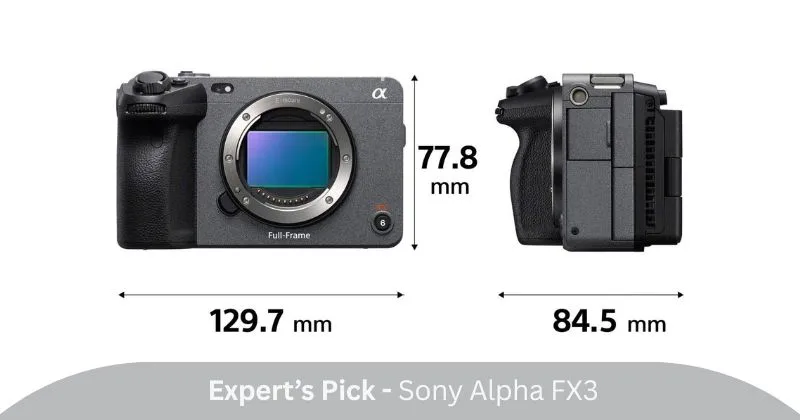
The Sony Alpha FX3 delivers cinema-grade quality in a compact, full-frame body, offering incredible low-light performance and smooth handheld footage for creators who need top-tier video on the go.
That was our top pick of low light mirrorless cameras this year. If you are confused, you can go with this. But if you want more options, feel free to check out a quick preview of our top 10 picks below-
Best Low Light Mirrorless Camera- A Quick Preview:
| Image | Name | Details | |
|---|---|---|---|
 | Canon EOS R5 Mark II Body |
| Check Price |
 | Sony Alpha FX3 |
| Check Price |
 | Sony Alpha ZV-E10 |
| Check Price |
 | Nikon Z 8 |
| Check Price |
 | Fujifilm X-T5 |
| Check Price |
 | Sony Alpha a6400 |
| Check Price |
 | Sony Alpha 6700 |
| Check Price |
 | Fujifilm X-M5 |
| Check Price |
 | Sony Alpha 7R V |
| Check Price |
 | Canon EOS R7 |
| Check Price |
So, how do you know which mirrorless camera is actually good in low light? With so many specs and marketing buzzwords flying around, it can feel overwhelming.
Don’t worry, we’ve got you covered. Here are the key things to look for when choosing a low-light mirrorless camera
What to Look For When Buying a Low-Light Mirrorless Camera
When evaluating mirrorless cameras for their low-light prowess, several key specifications and features come into play. Understanding these will empower you to make an informed decision:
Sensor Size:
Generally, larger sensors perform better in low light. Full-frame sensors (approx. 36x24mm) have larger individual photosites (pixels) compared to APS-C (approx. 23.5×15.6mm) or Micro Four Thirds sensors, allowing them to gather more light and produce cleaner images with less noise at higher ISO sensitivities.
ISO Range and Noise Performance:
The native ISO range indicates the camera’s ability to capture light without the need for digital amplification. More importantly, assess how well the camera manages noise at its higher ISO settings. A camera might have an expansive ISO range, but if the images are unusable due to excessive noise, it’s not truly a low-light performer. Look for BSI (Backside-Illuminated) sensors and advanced image processors that excel at noise reduction.
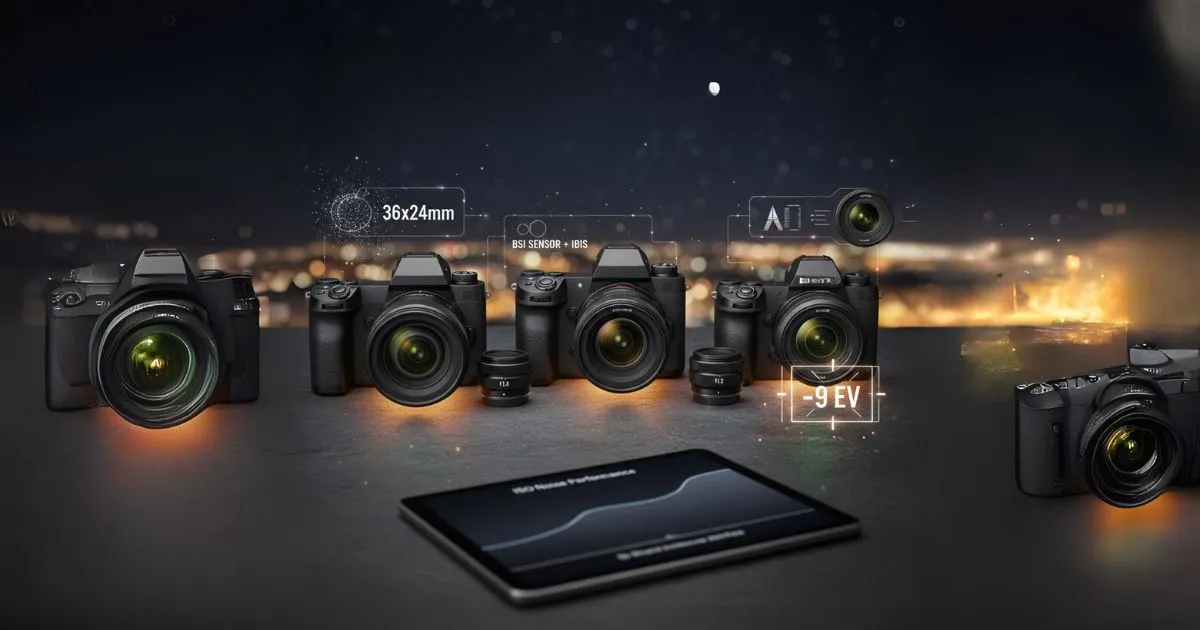
In-Body Image Stabilization (IBIS):
IBIS shifts the camera’s sensor to counteract camera shake. In low light, this allows you to use slower shutter speeds while still handholding the camera, reducing the need to push ISO as high and resulting in sharper images with less noise. Look for systems offering 5 to 8 stops of correction.
Autofocus Sensitivity (EV rating):
This refers to how dark a scene can be while the autofocus system can still reliably lock onto a subject. Measured in Exposure Value (EV), a lower negative EV number indicates better low-light autofocus. For instance, -6 EV is very good, while -9 EV is exceptional. Look for cameras with advanced subject tracking capabilities that perform well in dim conditions.
Lens Compatibility and Availability:
A camera’s low-light potential is only as good as the lenses you pair with it. Look for a system with a good selection of fast lenses (e.g., f/1.2, f/1.4, f/1.8, f/2.8) that allow more light to reach the sensor, further enhancing low-light performance and enabling shallower depth of field.
Video Low-Light Capabilities:
For videographers, consider features such as dual native ISO (which provides two distinct ISO settings where the sensor performs optimally with minimal noise), internal RAW recording, and high frame rates at low light (e.g., 4K 120p) for cinematic slow-motion effects.
Alright, so we’ve covered the must-have features. But let’s be real—you don’t want to dig through endless spec sheets. You want clear answers: Which camera should I buy? The good news is that we’ve done the research for you. Here are the details about the 10 best low-light mirrorless cameras that deliver when it matters most.
Top 10 Best Low Light Mirrorless Cameras of 2025
1. Canon EOS R5 Mark II Body
Best For: Professionals demanding high resolution, fast performance, and excellent low-light capabilities for both stills and video.
Rating: 9.2/10Reason: Combines a high-resolution stacked sensor with advanced processing and autofocus that excels in challenging light.
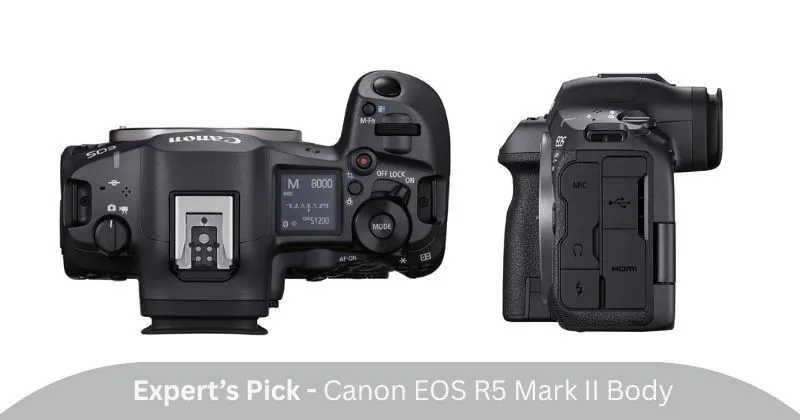
The Canon EOS R5 Mark II takes Canon’s high-performance mirrorless line to new heights. Equipped with a new 45-megapixel stacked full-frame sensor, it offers superb resolution and impressive speed. For low-light scenarios, the stacked sensor design, combined with the new DIGIC Accelerator and DIGIC X processors, significantly improves noise performance at high ISOs.
Its Dual Pixel Intelligent AF system can focus down to an impressive -6.5 EV (with an f/1.2 lens), ensuring accurate subject tracking even in very dim lighting. The camera also supports internal 8K RAW video at up to 60p, making it a powerful tool for capturing high-quality footage in challenging lighting conditions. With up to 8.5 stops of in-body image stabilization (IBIS), it allows for slower shutter speeds handheld, further aiding low-light capture.
| Sensor | Full-Frame Stacked CMOS |
| Resolution | 45 MP |
| IBIS | 8.5-Stop 5-Axis |
| AF Sensitivity | -6.5 EV |
| Video Capabilities | 8K 60p RAW |
| Storage | Dual Card Slots (CFexpress Type B & SD UHS-II) |
- Delivers incredibly detailed images and highly versatile video.
- Offers best-in-class image stabilization for super stable shots.
- Autofocus is exceptionally fast and reliable, even in challenging light.
- Robust build quality instills confidence for professional use.
- Dual card slots provide crucial redundancy for important shoots.
- Battery life can be quickly depleted during intensive use.
- Produces very large files, demanding robust storage and processing.
- The menu system can be dense and require a learning curve.
- Some users report a distracting mechanical shutter sound.
2. Sony Alpha FX3
Best For: Professional videographers and cinematographers prioritizing extreme low-light video performance.
Rating: 9.5/10Reason: Features a dual native ISO 12.1MP sensor that creates incredibly clean footage in near darkness.
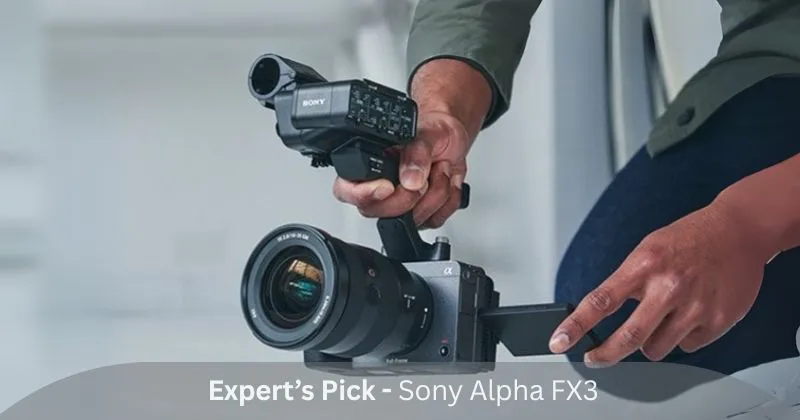
The Sony Alpha FX3 stands out for its remarkable low-light video capabilities. Its 12.1MP full-frame sensor is specifically designed for superior light gathering, leading to minimal noise even at very high ISO settings. This is further enhanced by its dual native ISO (ISO 640 and ISO 12800), which ensures optimal noise performance at these two key sensitivity points for video work.
The camera boasts advanced autofocus with real-time tracking, reliable even in dim lighting, and 5-axis in-body image stabilization for smooth handheld footage. Its robust, cage-free body design, with integrated mounting points and a detachable XLR handle, makes it a highly versatile tool for professional video production in challenging lighting conditions.
| Sensor | Full-Frame BSI CMOS |
| Resolution | 12.1MP |
| IBIS | 5-Axis |
| AF Sensitivity | -6 EV |
| Video Capabilities | 4K 120p, Dual ISO |
| Cooling System | Built-in Cooling Fan |
- Exceptional cinematic video quality, especially in low light.
- Compact, “cage-free” design is highly adaptable for rigging.
- Dual native ISO ensures exceptionally clean footage across a wide range of lighting conditions.
- The built-in cooling fan prevents overheating during extended takes.
- Integrated mounting points streamline setup for filmmakers.
- Lacks a built-in electronic viewfinder, hindering bright outdoor shooting.
- Relatively low still image resolution for a full-frame sensor.
- Requires external ND filters for bright conditions due to wide aperture.
- CFexpress Type A cards are expensive and have limited capacity.
3. Sony Alpha ZV-E10
Best For: Vloggers and content creators on a budget who need good low-light performance.
Rating: 7.5/10Reason: Offers impressive low-light ISO performance for an APS-C camera, especially given its price and compact size.
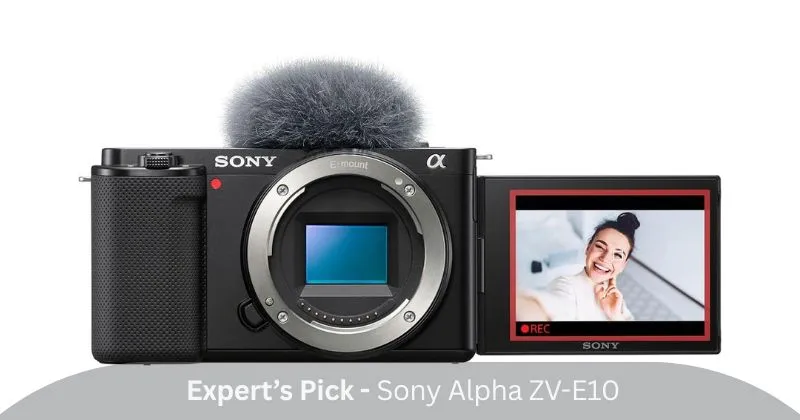
The Sony Alpha ZV-E10 is primarily aimed at vloggers, but its underlying imaging capabilities make it a surprisingly good performer in low light for an APS-C camera. It utilizes a 24.2MP APS-C Exmor CMOS sensor, which delivers clean images up to ISO 6400, and is still quite usable beyond that, especially when shooting RAW.
While it lacks in-body image stabilization (relying on digital stabilization for video), its autofocus system, inherited from more advanced Sony models, is responsive even in moderately dim conditions. Its vari-angle screen is practical for self-shooting in low-light environments, and its compact size makes it easy to carry for spontaneous night shooting.
| Sensor | APS-C Exmor CMOS |
| Resolution | 24.2MP |
| IBIS | Digital (Video Only) |
| AF Features | Real-time Eye AF |
| Video Capabilities | 4K 30p |
| Streaming | USB-C Live Streaming |
- Very affordable entry point for mirrorless video creation.
- Excellent built-in microphone for capturing clear audio.
- Fast and reliable autofocus with effective subject tracking for vlogging.
- The vari-angle screen is perfect for self-recording and capturing creative angles.
- Can livestream directly via USB-C for quick content sharing.
- No in-body image stabilization leads to shaky handheld footage.
- Pronounced rolling shutter can distort moving subjects in video.
- Lacks an electronic viewfinder, making bright conditions challenging.
- Limited physical controls require more menu diving.
4. Nikon Z 8
Best for: Professional photographers and videographers who need a robust, high-performance hybrid camera that excels in low-light conditions.
Rating: 9.3/10Reason: Delivers exceptional high ISO performance, class-leading autofocus sensitivity, and robust build for any conditions.
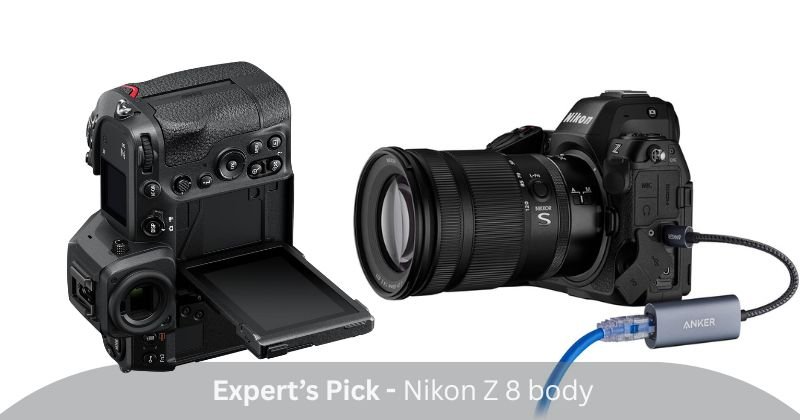
The Nikon Z 8 is essentially a more compact and affordable version of Nikon’s flagship Z 9, offering incredible value for professionals. It features a 45.7MP full-frame stacked CMOS sensor, offering an impressive balance of resolution and low-light performance. The sensor design, combined with the EXPEED 7 processor, yields remarkably clean images even at high ISO settings, with noise being exceptionally well controlled.
Its autofocus system is a standout, capable of focusing down to an astonishing -9 EV (with Starlight Mode and an f/1.2 lens), making it one of the best in class for extreme low-light conditions. The 5-axis in-body image stabilization provides up to 5.5 stops of correction, further enhancing its ability to capture sharp images and stable video handheld in dim light.
| Sensor | Full-Frame Stacked CMOS |
| Resolution | 45.7MP |
| IBIS | 5.5-Stop 5-Axis |
| AF Sensitivity | -9 EV (Starlight Mode) |
| Video Capabilities | 8K 60p N-RAW |
| Shutter Type | Electronic Shutter-Only |
- Boasts incredibly precise autofocus, even in near-dark conditions.
- Offers flagship-level performance in a more manageable size than the Z9.
- Capable of professional 8K RAW video recording internally.
- The electronic shutter-only design enables silent and high-speed shooting.
- Excellent overall image quality for both stills and video.
- Battery life can be shorter compared to some professional DSLRs.
- It can be physically large and heavy for extended use with handheld devices.
- Some users find the EVF resolution less impressive than rivals.
- Occasional overheating reports have been received with extremely prolonged 8K video playback.
5. Fujifilm X-T5
Best For: Enthusiasts and professionals seeking a compact, high-resolution APS-C camera with excellent low-light performance and a classic shooting experience.
Rating: 8.8/10Reason: Impressive 40.2MP APS-C sensor delivers surprisingly good high ISO images with effective IBIS.
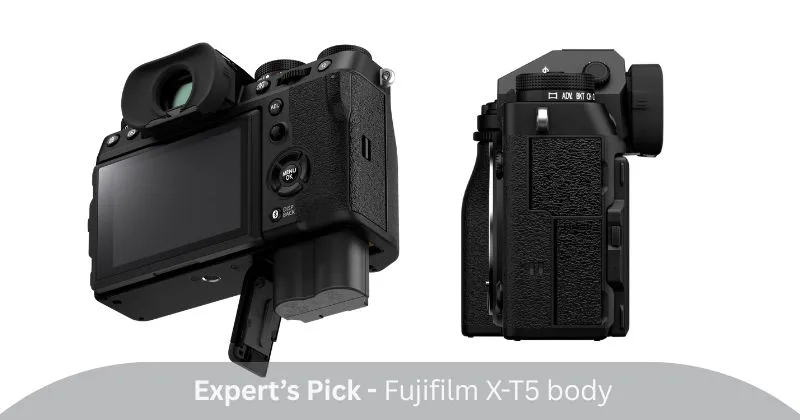
The Fujifilm X-T5 blends retro-inspired design with cutting-edge imaging technology. It features Fujifilm’s latest 40.2MP APS-C X-Trans CMOS 5 HR sensor, which, despite its high resolution for an APS-C chip, excels at managing noise at higher ISOs. Images remain clean and detailed up to ISO 6400, and even higher with careful processing.
Crucially for low light, the X-T5 boasts a powerful 5-axis in-body image stabilization system offering up to 7 stops of compensation, allowing photographers to handhold at significantly slower shutter speeds. Its updated autofocus system, featuring deep-learning AI, is also highly capable, providing accurate subject detection and tracking even in challenging lighting conditions.
| Sensor | APS-C X-Trans CMOS 5 HR |
| Resolution | 40.2MP |
| IBIS | 7-Stop 5-Axis |
| AF Features | AI Subject Detect |
| Video Capabilities | 6.2K 30p |
| Control Style | Dial-Based Controls |
- Produces stunning 40MP images with Fujifilm’s signature color science.
- Features highly effective 7-stop in-body image stabilization.
- Tactile, dial-based controls provide a satisfying, classic shooting experience.
- Compact and robust, ideal for travel and enthusiast use.
- Strong low-light performance for an APS-C sensor.
- Video features, while good, aren’t as comprehensive as some competitors.
- A tilting-only screen is less versatile than a full vari-angle screen for vlogging.
- Large RAW file sizes demand more storage space.
- Some users report issues with autofocus hunting in specific bright conditions.
6. Sony Alpha a6400
Best For: Budget-conscious photographers and aspiring videographers seeking an affordable entry into mirrorless with decent low-light capabilities.
Rating: 7.0/10Reason: Provides reliable autofocus and acceptable low-light performance for its price, especially with fast lenses.
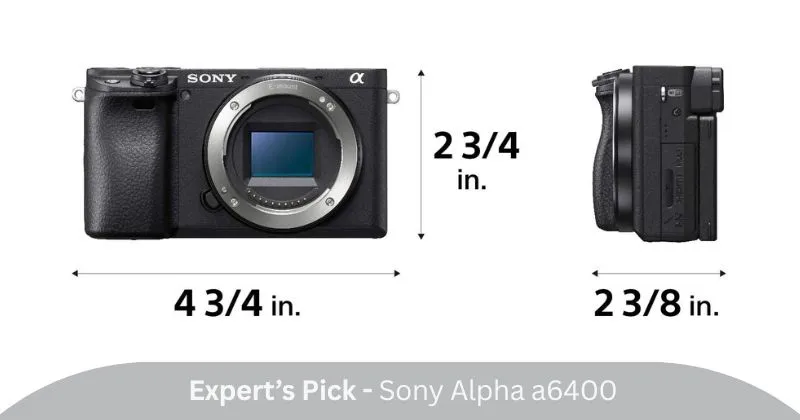
The Sony Alpha a6400 remains a popular choice for its balance of features and affordability. While it’s an older APS-C model with a 24.2MP sensor, it still offers acceptable low-light performance. Images are generally clean up to ISO 3200-6400, with noise becoming more pronounced at higher sensitivities.
Its standout feature for its price is its highly effective Real-time Tracking and Real-time Eye AF, which can lock onto subjects quickly and accurately, even in moderately dim conditions. However, it lacks in-body image stabilization, so steady hands or fast lenses are essential for sharp low-light handheld shots.
| #colspan | |
|---|---|
| Sensor | APS-C Exmor CMOS |
| Resolution | 24.2MP |
| IBIS | No |
| AF Features | Real-time Eye AF & Tracking |
| Video Capabilities | 4K 30p |
| Screen | 180° Flip-Up Touchscreen |
- Offers exceptional autofocus speed and subject tracking for its price.
- Compact and lightweight, making it easy to carry daily.
- Convenient 180° flip-up screen is great for vlogging and selfies.
- Provides unlimited 4K video recording time.
- Reliable performance for both still photography and casual video.
- Lacks in-body image stabilization, making handheld video prone to shake.
- Outdated menu system is less intuitive than newer Sony cameras.
- Touchscreen functionality is limited to selecting focus points, not navigating menus.
- Single, slower UHS-I SD card slot.
7. Sony Alpha 6700
Best for: APS-C users seeking advanced autofocus and enhanced low-light video capabilities in a compact body.
Rating: 8.5/10Reason: Features Sony’s latest AI processing and a BSI sensor for enhanced low-light performance in a compact APS-C form.
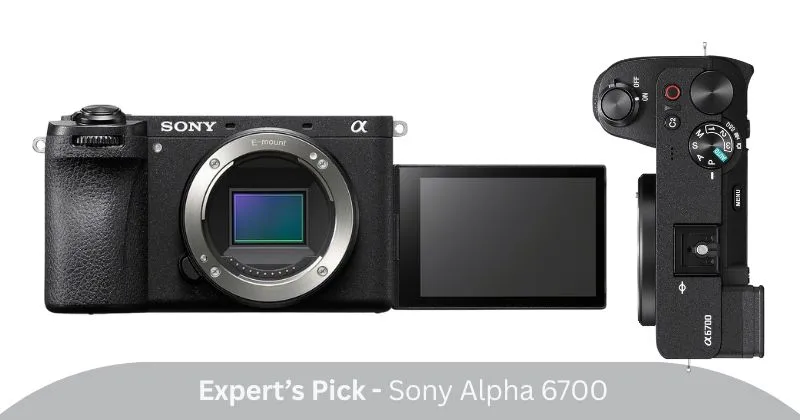
The Sony Alpha 6700 represents a significant upgrade in Sony’s APS-C line, bringing many features from its full-frame counterparts. It features a new 26.0MP APS-C Exmor R BSI CMOS sensor and the BIONZ XR processor, which enhance low-light performance and dynamic range compared to older APS-C models. Images show good detail and manageable noise up to ISO 12800.
A key highlight is its AI Processing Unit, which significantly enhances autofocus accuracy and subject recognition, allowing it to perform well even in challenging low-light environments (AF sensitivity down to -3 EV). The 5-axis in-body image stabilization provides up to 5 stops of compensation, crucial for sharp handheld photos and stable video in dim light.
| #colapan# | |
|---|---|
| Sensor | APS-C Exmor R BSI CMOS |
| Resolution | 26.0MP |
| IBIS | 5-Stop 5-Axis |
| AF Features | AI Processing Unit |
| Video Capabilities | 4K 120p |
| Viewfinder | 2.36m-dot XGA OLED EVF |
- Features cutting-edge AI-powered autofocus with advanced subject recognition.
- Delivers impressive 4K video capabilities, including 4K 120p.
- Effective 5-stop in-body stabilization for sharper handheld results.
- Improved ergonomics and a fully articulated touchscreen enhance usability.
- Offers excellent image quality thanks to its advanced APS-C sensor.
- Still limited by a single SD card slot.
- May experience overheating during prolonged high-resolution video playback.
- The electronic viewfinder resolution is not as high as that of some premium models.
- High ISO performance, while good for APS-C sensors, doesn’t match that of full-frame sensors.
8. Fujifilm X-M5
Best For: Casual photographers and vloggers seeking a stylish, compact camera with good low-light imaging and straightforward controls.
Rating: 7.2/10Reason: Offers good low-light image quality from its 26.1MP APS-C sensor, coupled with strong autofocus for its class.
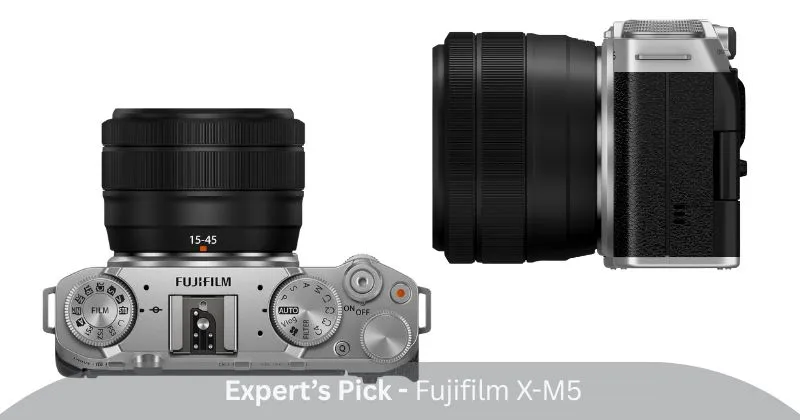
The Fujifilm X-M5 is designed for simplicity and portability, yet it packs a capable 26.1MP APS-C X-Trans CMOS 4 sensor and the newer X-Processor 5. This combination allows it to deliver good low-light image quality, with clean results up to ISO 6400 and usable files at higher sensitivities. Its autofocus system, benefiting from the X-Processor 5, includes improved subject detection and performs reliably in various lighting conditions.
However, it’s important to note that the X-M5 lacks in-body image stabilization (IBIS), meaning you’ll need to rely on lens stabilization, faster shutter speeds, or higher ISOs to counteract camera shake in dim environments. Its fully articulating touchscreen makes it user-friendly for vlogging and creative angles in any light.
| Sensor | APS-C X-Trans CMOS 4 |
| Resolution | 26.1MP |
| IBIS | No |
| AF Features | Improved Subject Detect |
| Video Capabilities | 4k |
| Creative Modes | 18 Film Simulation Modes |
- Produces beautiful images with Fujifilm’s signature color and film simulations.
- Extremely lightweight and compact, perfect for portability.
- Offers a stylish, minimalist design with easy-to-use creative modes.
- Good low-light image quality for an APS-C camera in its class.
- An accessible entry point into the Fujifilm X-series ecosystem.
- Absence of in-body image stabilization is a significant drawback for handheld.
- Lacks a built-in electronic viewfinder, challenging bright outdoor use.
- The small grip can be uncomfortable with larger lenses.
- Battery life is relatively short, requiring the use of spare batteries.
9. Sony Alpha 7R V
Best For: Landscape, portrait, and studio photographers who need extreme resolution and advanced autofocus with very good low-light capabilities.
Rating: 9.0/10Reason: High-resolution full-frame sensor delivers excellent detail and strong low-light performance, aided by exceptional IBIS and AI-driven AF.
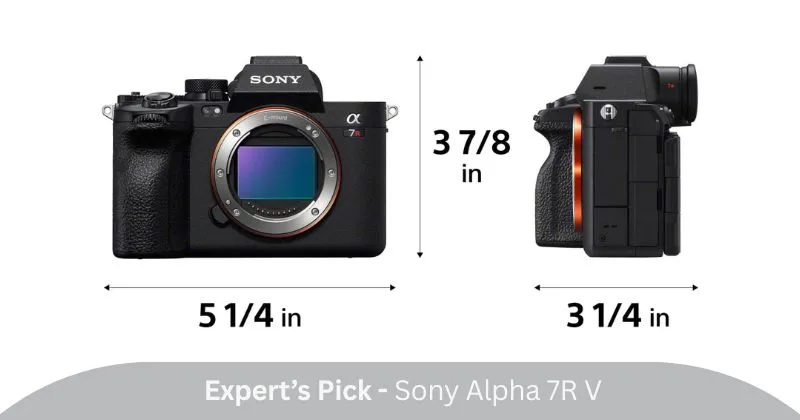
The Sony Alpha 7R V is a marvel of resolution and technological innovation. Its 61MP full-frame Exmor R BSI CMOS sensor delivers unparalleled detail. Despite the high pixel count, its backside-illuminated design and powerful BIONZ XR processor ensure very good low-light performance, producing detailed images with well-controlled noise up to ISO 12800.
A standout feature is its revolutionary AI Processing Unit, which powers the most advanced autofocus system in a Sony camera, providing highly accurate subject recognition and tracking even in challenging lighting conditions (AF sensitivity down to -4 EV). The 8-stop 5-axis in-body image stabilization is also incredibly effective, allowing for extremely slow handheld shutter speeds, which is a massive advantage in low light for both stills and video.
| Sensor | Full-Frame Exmor R BSI CMOS |
| Resolution | 61MP |
| IBIS | 8-Stop 5-Axis |
| AF Sensitibity | -4 EV |
| Video Capabilities | 8K 24p/25p |
| Display | Multi-angle LCD Monitor |
- Delivers unparalleled image detail from its 61MP full-frame sensor.
- Features a revolutionary AI-driven autofocus system with superior recognition.
- Outstanding 8-stop in-body image stabilization for sharp handheld results.
- Highly versatile multi-angle LCD screen offers incredible flexibility.
- Excellent dynamic range and high ISO performance for a high-resolution sensor.
- Generates extremely large file sizes, requiring significant storage and powerful hardware.
- 8K video has noticeable crop and rolling shutter artifacts.
- A premium price point makes it a significant investment.
- Can feel overly complex for photographers new to advanced features.
10. Canon EOS R7
Best For: Wildlife and sports photographers seeking a fast APS-C camera with strong low-light autofocus and good reach.
Rating: 8.3/10Reason: High-resolution APS-C sensor combines with excellent IBIS and fast autofocus for reliable low-light performance.
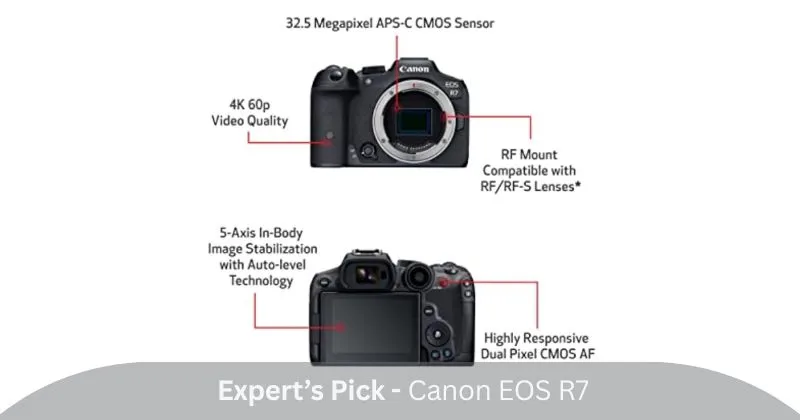
The Canon EOS R7 marks a significant entry into Canon’s APS-C mirrorless lineup. Featuring a 32.5MP APS-C CMOS sensor, it offers a great balance of resolution and speed. For low-light situations, the sensor, combined with the DIGIC X processor, offers effective noise management, producing usable images up to ISO 6400-12800.
Its Dual Pixel CMOS AF II system, inherited from higher-end R-series cameras, is incredibly fast and precise, with an AF working range down to -5 EV (with an f/1.2 lens), making it very capable of locking onto subjects in dim conditions. The 5-axis in-body image stabilization provides up to 8 stops of correction with coordinated control IS, which is a major advantage for handheld low-light shooting and video stability.
| Sensor | APS-C CMOS |
| Resolution | 8-Stop 5-Axis |
| IBIS | 8-Stop 5-Axis |
| AF Sensitivity | -5 EV |
| Video Capabilities | 4K 60p (oversampled) |
| Max Burst | 30 fps Electronic Shutter |
- Offers exceptionally fast burst shooting, making it ideal for capturing action and wildlife.
- Boasts best-in-class 8-stop in-body image stabilization for an APS-C camera.
- Highly effective Dual Pixel CMOS AF II with advanced subject tracking.
- Provides a strong balance of resolution and speed for dynamic subjects.
- Durable, weather-sealed build with convenient dual SD card slots.
- The electronic viewfinder resolution is lower than that of some competitors.
- The native RF-S lens lineup is currently limited.
- High ISO performance, while good for APS-C cameras, falls short of that of full-frame cameras.
- Some users have reported concerns about the mechanical shutter’s reliability.
So, you’ve seen the top low-light mirrorless cameras of 2025—but which one is truly the right fit for you? Features, lenses, and usability all matter, and that’s where a quick buyer’s guide comes in handy. Let’s break down what to look for so you can make the best choice in any lighting.
Read our explained – Canon 6D vs 6D Mark II: Full Comparison Guide.
Choosing the best camera for low light means understanding how key features impact performance. Here’s what to prioritize:
Sensor Size:
Larger sensors (full-frame) capture more light, significantly reducing noise at higher ISOs compared to smaller (APS-C) ones. For ultimate low-light performance, consider Sony Alpha FX3, Nikon Z 8, Canon EOS R5 Mark II, or Sony Alpha a7R V.
ISO Performance & Noise Management:
Beyond just a high max ISO, look for cameras that handle noise well at elevated sensitivities. This means advanced sensors (like BSI) and powerful processors. Cameras like the Sony Alpha FX3 (video), Nikon Z 8, Canon EOS R5 Mark II, Sony Alpha a7R V (still), Fujifilm X-T5, and Sony Alpha a6700 excel in this area.
In-Body Image Stabilization (IBIS):
IBIS shifts the sensor to counteract camera shake, allowing you to use slower shutter speeds in dim light for sharper, handheld images without having to boost the ISO as much. The Canon EOS R5 Mark II, Canon EOS R7, Sony Alpha a7R V, and Fujifilm X-T5 offer excellent IBIS.
Autofocus (AF) Sensitivity:
AF sensitivity (measured in negative EV) indicates how dark a scene can be for accurate focusing. Lower negative numbers indicate better low-light autofocus performance. Look for advanced subject detection. Nikon Z 8, Canon EOS R5 Mark II, Sony Alpha FX3, and Canon EOS R7 lead in low-light AF.
Fast Lenses:
Lenses with wide apertures (small f-numbers, such as f/1.4 or f/2.8) allow more light to enter, enabling lower ISOs and faster shutter speeds in low-light conditions. They also create a beautiful background blur. All cameras on this list pair well with fast prime or zoom lenses. Prioritize investing in these alongside your camera body.
Video-Specific Needs:
For videography, prioritize features like dual native ISO (for cleanest footage), high bit-depth recording (10-bit 4:2:2), and robust codecs (RAW/ProRes) for post-production flexibility. Additionally, consider high frame rates for slow-motion footage in low-light conditions. The Sony Alpha FX3 and Sony Alpha a6700 are standout choices for low-light video.
Balance Resolution with Low-Light:
High megapixel counts don’t always mean better low-light. Sometimes, lower MP sensors can perform better in extreme darkness due to larger individual pixels. Balance your need for fine detail with clean high ISO performance. For ultimate clean low-light video, consider the lower-MP Sony Alpha FX3. For high-resolution stills with strong low-light, the Sony Alpha a7R V is excellent.
User Experience:
Consider ergonomics, intuitive controls, and screen flexibility (like a vari-angle touchscreen) for a more enjoyable and efficient shooting experience, especially in challenging low-light situations. The Sony Alpha ZV-E10 and Sony Alpha a7R V offer great screen flexibility, while the Fujifilm X-T5 provides tactile, intuitive controls.
Frequently Asked Questions (FAQs)
1. What is the most important factor for low-light performance?
Sensor size is generally the most important, with full-frame cameras excelling, followed closely by a camera’s high ISO noise management and effective image stabilization.
2. Can APS-C cameras perform well in low light?
Yes, modern APS-C cameras, such as the Fujifilm X-T5 and Sony Alpha 6700, offer very good low-light performance, especially when paired with fast lenses.
3. What is in-body image stabilization (IBIS) and how does it help in low light?
IBIS moves the camera sensor to counteract shake, allowing you to use slower shutter speeds handheld without blur, thereby reducing the need for high ISO settings.
4. What does “AF sensitivity down to -X EV” mean?
It indicates the lowest light level (measured in Exposure Value) at which the camera’s autofocus system can still reliably achieve focus, with lower negative numbers meaning darker conditions.
5. Do I still need fast lenses if my camera has good low-light ISO?
Yes, fast lenses (e.g., f/1.4) let in more light, allowing for lower ISOs and faster shutter speeds, which always results in cleaner and sharper images in dim conditions.
6. Is full-frame always better than APS-C for low light?
Generally, yes, due to larger pixels, but advanced APS-C cameras can close the gap significantly, especially with good processing and IBIS.
Conclusion
Mirrorless cameras have revolutionized low-light photography, offering exceptional performance even in the dimmest environments. By understanding key features like sensor capability, stabilization, and autofocus, you can find the perfect model to match your creative needs. This technology empowers you to confidently capture stunning images and videos, ensuring your vision shines brightly, no matter how challenging the lighting conditions.


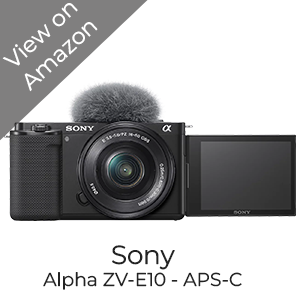



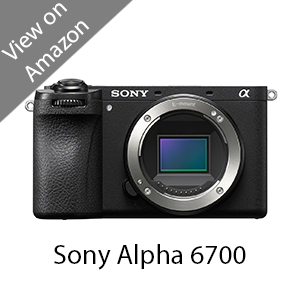



Leave a Reply